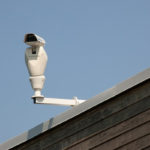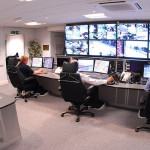Surveillance Camera Features
Choosing the right video surveillance system can be tough. With various technologies to consider, as well as your own personal requirements, there’s a lot to consider. For your convenience, here are some common terms and technologies to help you choose the right video surveillance system for you.
Resolution
Because of our smart, HD televisions, we are all likely familiar with resolution as well as the units used to measure it (pixels). From its beginnings at 720 pixels to 1080p, we are now up to 4K and 5K resolution, with further advancements on the horizon.
The goal for resolution is to produce the clearest image for usability. This is defined by detection, recognition and identification and generally requires 80p around the face. Previously, pan, tilt, and zoom (PTZ) technology was employed to get a usable image. Now that camera resolution has greatly improved, less features and cameras are necessary to create high quality video surveillance.
Frame Rate
Another term you are likely familiar with is frame rate. The minimum requirement for the HDTV standard is 30 frames per second (fps). A higher frame rate is ideal, as it will produce a smooth, clearer video, however, it may not be practical. A higher frame rate also requires more bandwidth and storage space as these tend to be larger files. In this case, you should evaluate and prioritize your needs to determine the frame rate for you.
Networks & Storage
Security cameras are a small percentage of the overall cost of a surveillance system (the cost for cables and storage quickly accumulates). With that in mind, you should figure out what you intend to do with the footage so you can make the best decision for networks and storage. For example, ask yourself if you would like to store the footage for later review, actively monitor your feed, or would you like to do both.
Once you determine your goals and how long you need to retain footage (if at all), you can figure out how much space is necessary before your data gets overwritten. Depending on your system and needs, you may be able to refine these details per camera/location as necessary.
Video Compression
Since higher frame rates lead to larger files and more required storage, video compression technology works to counter that. As it advances, it promises to reduce bandwidth and storage to provide more affordable and convenient options for consumers. Currently, H.264 and H.265 are the standard, depending on the cameras you choose.
Light Sensitivity
As you may know, extreme light levels can interfere with a security camera’s ability to capture useful images. However, low light technologies have improved and can produce images in little to no light environments. For example, ‘lightfinder’ technology enables cameras to produce color video down to below one lux (one lux is a dark room, zero lux is an absence of light).
There’s also wide dynamic range, which allows cameras to capture usable images in varying lighting conditions. This feature adjusts and filters light to prevent washed out images, and is useful for hallways and doorways that can open into bright lights.
Software
While most systems come equipped with software (which should be updated and patched regularly and as necessary), you can find and install software applications that deliver specialized features and functions that you desire. Just remember that the higher the cost of the system means more features, which can translate into more training required to learn how to use it.
If you have any questions about security cameras or need help choosing surveillance systems and equipment, please feel free to contact us at 888-203-6294. You may also browse our stock online at SecurityCamExpert.com or connect with us on Facebook, Google+, Twitter, LinkedIn, and Pinterest.
Artificial Intelligence For Video Surveillance
There’s no denying that video surveillance technology has come a long way over the years. From grainy videos in its early stages to the quality software and clarity today, video surveillance continues to make great strides and advancements.
History
The goal of security cameras and surveillance systems is to capture, detect, and deter any unlawful behavior in and around homes, businesses, and public areas. Before, installing a security camera system was a costly and laborious job, involving lots of wires and cables running throughout the building. As technology progressed, security cameras became more accessible and affordable, allowing more users the opportunity to invest in their security. Now there are numerous DIY solutions that make it easy for homeowners to install and set up on their own security systems.
For businesses, implementing a team of people to actively monitor security cameras at all times was once the only option. Now, much of the monitoring aspect of security and surveillance systems can be automated. Rather than having the mundane task of watching numerous monitors, security cameras now have the ability to detect any suspicious or abnormal behaviors and will alert a security officer as necessary.
While we have seen the security industry flourish over the years, this is just the tip of the iceberg. Our technology will continue to advance and amaze us in ways we never thought possible.
Artificial Intelligence
Artificial intelligence (AI) in video surveillance enables the “smart” features we now see with security cameras. In general, security cameras enable us to monitor situations in real-time or go back to review previous footage. With the integration of AI technology, not only can we monitor in real-time, but potential issues can be identified before they become real problems.
With the emergence of video analytics, footage can be analyzed immediately to identify any abnormal activity or threats early on. This technology helps the software ‘learn’ what is normal in order to identify unusual behavior and is meant to make up for human error, rather than replace human monitoring all together.
While it was always a goal to integrate AI and video surveillance, the technology, from a hardware standpoint, was not ready. One of the issues that needed to be addressed was decreasing the power demand to a level low enough that would allow the technology to be embedded into the cameras.
As more cameras emerge with new AI technologies and processes, we will begin to see more advanced features including crowd density monitoring, facial recognition, stereoscopic vision, and behavior analysis.
Behavior analysis in particular is what a lot of tech companies are focusing on. By implementing a technology that can identify and recognize precursor patterns associated with crimes and other bad behavior, we may be able to greatly improve public safety and security.
A great example comes from the West Japan Railway, where it was found that 60% of people hit by trains in Japan were intoxicated. They have now installed security cameras that can automatically search for and detect signs of intoxication. Sleeping on benches, stumbling, falling, or standing motionless for long periods of time are behaviors that are recognized by the AI system. Human attendees are then notified and sent to check on the person.
Of course, a conversation about video surveillance always includes concerns about privacy. No one wants to feel like they are constantly being monitored, but developers insist that these systems know when to stop collecting information and monitoring. As these technologies continue to develop, you may soon be able to “teach” your system when to record and in which situations recording should halt.
Although it is still in its early stages, AI technology and video surveillance is heading in a positive and exciting direction. Mass adoption may still be a ways to go, but it’s great to see AI being applied in a new setting.
What are your thoughts on artificial intelligence and the video surveillance industry? Share with us on Facebook, Google+, Twitter, LinkedIn, and Pinterest. Browse our selection of security cameras and equipment online at SecurityCamExpert.com. To learn more about our installation services or to request a free quote, please call 888-203-6294.

